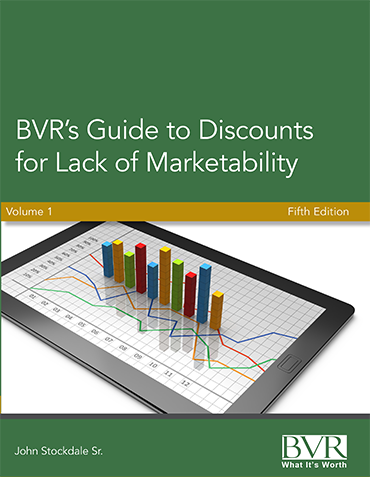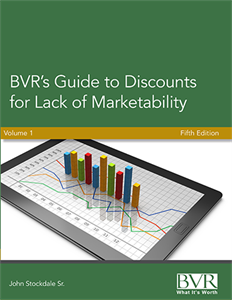BVR's Guide to Discounts for Lack of Marketability, Fifth Edition (2 Volumes)
August 2013 978-1-62150-025-4 Hardcover, PDF (644 pages)
John Stockdale Sr.
Business Valuation Resources, LLC
In the fifth edition of BVR's Guide to Discounts for Lack of Marketability, John Stockdale, Sr. offers the newest treatise on the theories, evidence, and techniques for determining discounts for lack of marketability (DLOM). DLOM is one of the most discussed topics in the business valuation profession with a historically wide divergence in how valuators approach it. This valuable, two-volume resource offers practical guidance for determining the DLOM and includes a compendium with analysis of over 100 of the most important cases that have made it into the courts. Case reviews shed light on how judges have viewed experts' use of the relevant facts and economic principles to determine a DLOM.
Highlights of this new edition include:
- Insight into the IRS view on DLOM
- Expanded commentary on the liquidity premium
- Increased coverage of restricted stock studies, now including 32 studies
- Additional insight on the factors related to restricted stock discounts
- Expanded discussion of pre-IPO studies, and minority public stock evidence
- Additional studies on the matched pairs approach and discounts in private companies
- Expanded section on volatility models, including the Sigma-DLOM Curve
- Computational methods and models including the revised Finnerty and the Ghaidarov Average Strike Put Option
- Comprehensive and easy-to-read court case summary table
Table of Contents
Volume One
- Introduction
- Chapter 1. Fundamentals of the Discount for Lack of Marketability
- 1.1 History of the DLOM
- 1.2 The Need for a Discount for Lack of Marketability
- 1.3 Requirements of Valuation Standards
- 1.4 Theory of the DLOM
- 1.5 Base Value and the Relevant Market
- 1.6 Liquidity Concepts
- 1.7 Insight Into the IRS View on DLOM
- Chapter 2. Restricted Stock Studies, Private Placements, and PIPEs
- 2.1 Restricted Stock Background Data
- 2.2 Summary of Restricted Stock Studies
- 2.3 Commercial Databases
- 2.4 Analysis of Restricted Stock Data
- 2.5 A Different Type of Study
- 2.6 DLOM Evidence From Chinese Markets
- 2.7 An Analysis of the Private Placement Discount in Canada
- 2.8 Revenue Ruling 77-287
- 2.9 Limitations of Restricted Stock Studies
- Chapter 2 Appendix. Rev. Rul. 77-287, 1977-2 CB 319, IRC Sec(s). 2031
- Chapter 3. Pre-IPO Studies
- 3.1 Emory Business Valuation Studies
- 3.2 Valuation Advisors Database
- 3.3 Willamette Management Associates Studies
- 3.4 Criticisms of Pre-IPO Studies
- 3.5 Statistical Analysis of Valuation Advisors Pre-IPO Data
- Chapter 4. Other Minority Public Stock Evidence
- 4.1 Event Studies
- 4.2 LEAPS-Long-Term Equity Anticipation Securities
- 4.3 Publicly Traded Shares in Private Equity Funds
- 4.4 REIT Price/Net Asset Value 'Discounts'
- 4.5 Bid-Ask Spread
- Chapter 5. The Private Company Discount or Matched Pairs Approach
- 5.1 Phillips and Freeman Study
- 5.2 Koeplin, Sarin, and Shapiro Study
- 5.3 Kooli, Kortas, and L'her Study
- 5.4 De Franco, Gavious, Jin, and Richardson Study
- 5.5 Officer Study
- 5.6 Block Study
- 5.7 Dodel Dissertation
- 5.8 Harjoto and Paglia Studies
- 5.9 Private Company Discounts in the Nordic Region
- Chapter 6. Observed Discounts in Private Companies
- 6.1 Coolidge Private Company Study
- 6.2 Secondary Trades of Publicly Registered Limited Partnership Units
- 6.3 Partnership Profiles Data About Secondary Trades
- 6.4 Pepperdine Private Capital Markets Project Survey Reports
- Chapter 7. Factors Affecting the DLOM Derived From Restricted Stock Studies
- 7.1 The Underlying Cause for Discounts-Is It Only Illiquidity That Is Important?
- 7.2 Registration Rights
- 7.3 Analysis of Factors From 26 Restricted Stock Studies
- 7.4 Problems With Using Regression Equations Directly
- 7.5 Industry in Which the Company Operates
- 7.6 Dividends
- 7.7 Basic Approach for Applying the DLOM
- 7.8 Comments About Block Size
- Chapter 8. Theory and Evidence Nexus-The Sigma DLOM Curve
- 8.1 The Gap Between Available DLOM Evidence and Private Companies
- 8.2 Analysis of Restricted Stock Data Based on Theory
- Chapter 8 Appendix. Development of the Sigma DLOM Curve to Connect Theory and Evidence
- Chapter 9. Volatility Models
- 9.1 The Chaffe Put Option Model
- 9.2 Longstaff Lookback Put Option
- 9.3 Finnerty Average Strike Put Option
- 9.4 Ghaidarov Average Strike Put Option
- 9.5 Meulbroek CAPM
- 9.6 Tabak CAPM
- 9.7 The Sigma-DLOM Curve
- 9.8 A Limitation of Volatility Models
- Chapter 9 Appendix. Notes on Specific Factors Relevant to Testing the Models Using the Databases
- Chapter 10. Practitioner Methods
- 10.1 Economic Components Model
- 10.2 VFC Longstaff Methodology
- 10.3 The Quantitative Marketability Discount Model
- 10.4 Rate of Return Method
- 10.5 Time Model
- 10.6 The NICE Method
- Chapter 11. Comparative Factor Analysis
- 11.1 Mandelbaum Comparative Factor Analysis
- 11.2 Expanded Factors From the IRS DLOM Job Aid
- 11.3 Comparative Analysis Using the Sigma-DLOM Curve or a Mathematical Model and Factors From Restricted Stock Studies
- 11.4 Comparative Analysis of Restricted Stock (FMV CARS)
- 11.5 Comparative Analysis Using the Pluris DLOM Database
- 11.6 Analysis of the DLOM in the Holman case
- Chapter 12. Methods for Tiered Entities
- 12.1 Evidence Regarding Discounts in Tiered Entities
- 12.2 Tax Court Cases Regarding Discounts in Tiered Entities
- 12.3 Income Approach Method
- 12.4 Asset-Based Approach
- Chapter 13. Which Computational Method Should Be Used?
- 13.1 Longstaff Lookback Put
- 13.2 Chaffe Put Option
- 13.3 Finnerty Average Strike Put Option
- 13.4 Ghaidarov Average Strike Put Option
- 13.5 Meulbroek CAPM Model
- 13.6 Tabak CAPM Model
- 13.7 The VFC Longstaff Methodology
- 13.8 The Qualitative Marketability Discount Model
- 13.9 Stockdale Time Model
- 13.10 Economic Components Model
- 13.11 Mandelbaum Comparative Factor Analysis
- 13.12 FMV Opinions and Pluris Comparative Analysis of Restricted Stock (CARS)
- 13.13 Johnson Jefferies Park Rate of Return Method
- 13.14 The NICE Method
- 13.15 Masten Webb Tiered Entity Income Approach
- 13.16 Frazier Tiered Entity Asset-Based Approach
- 13.17 LEAPS Put Options
- Chapter 14. Disposal Period
- 14.1 Why the Term 'Disposal Period'?
- 14.2 Disposal Period for Controlling Interests
- 14.3 Howard Frazier Barker Elliott Partnership Retirement Study
- 14.4 Time to Sell a Minority Interest in a Private Company
- Chapter 14 Appendix. Statistical Analysis of Time to Sale in
- Pratt's Stats and BIZCOMPS
- Chapter 15. Estimation of Synthetic Volatility for a Private Company
- 15.1 Volatility Background
- 15.2 Determining Volatility of Financial Factors as a Minimum Indication of Stock Volatility
- 15.3 Getting at Volatility Through Rate of Return
- 15.4 Use of Guideline Companies
- 15.5 General Range of Volatility of Public Companies
- 15.6 Determining Volatility of an Appropriate Sector Index
- 15.7 Reaching a Conclusion as to the Appropriate Volatility
- Chapter 16. DLOMs for Controlling Interests
- 16.1 Evidence of Controlling Interest DLOMs
- 16.2 Controlling Interest DLOMs in Tax Cases
- 16.3 Theoretical Basis for Controlling Interest DLOMs
- 16.4 Arguments Against Controlling Interest DLOMs
- 16.5 Computational Models
- 16.6 Example Use of Time Model to Determine a Controlling Interest DLOM
- Chapter 17. Conclusion: Where We Are With DLOMs
- 17.1 What We Do Have
- 17.2 What We Do Not Have
- 17.3 A Suggested Overall Procedure to Determine a DLOM
Volume Two: Case Law
- Introduction
- Court Case Summary Table
- Court Case Abstracts

